Books
Books

(Forced) Movement
What would be of contemporary culture if we did not recognize the impact of migration in cultural and socio-economic crossings? This book explores human migration in different times, contexts, and geographies surrounding the Aegean Sea. Through an assemblage of voices, lived experiences, historical documents, urban and rural dislocations, this publication examines responses to mobility of the ones on the move, and of the ones living in the destinations the former are heading to. It speaks of the sacrifices one is forced to make en route and at its antipode; the implications of voluntary migration to a place, steered by investment in real estate.
(Forced) Movement
by Antigone Samellas
Amygdalia
by Christina Phoebe
To live in the Borderlands means you
by Gloria Anzaldua
In the Great Mara River
by Liwaa Yazji
Real-Estate Cosmopolitanisms
by George Papam
Uprootings/Xerizomoi
by Nicolas Lakiotakis

Architectures of Healing
Today, many feel fettered by insomnia, untouchability, and restrictions on movement. Looking for a more holistic approach to bodily and mental health, this book explores architectures and elementary forms of care and healing in different time periods: from the powers of sleep, touch, and travel in Asklepieia, the ancient healing temples for divine dream encounters alleviating the pain of the ailing pilgrim; to the attentiveness carried through the healing touch from the establishment of Byzantine hospitals till our times; to a pilgrimage center in modern-day Lesbos on a personal search for healing from the traumas of war and patriarchy; to the liberating and self-preserving powers of sleep as a healing response to past and current systems of oppression.

HOOT nr. 6 — Vir Andres Hera
Gufo, Clément Faydit and 1 more
Été 2021, Vir Andrès est à Marseille, en résidence aux ateliers Triangle-Astérides. Nous somme aperçu-e-s furtivement à un banquet intilué "Le temps que l'huile se colore" que nous avons préparé avec les différent-e-s membres de l'ateliers Vé. Il y avait des bols de glace qui fondaient, des soupes et des préparations fruitées, à la coriandre, aux abricots, au fenouil, des brioches et des chapeaux en pain. Vir était accompagné d'ami-e-s. Il a demandé "Où est Gufo?" alors je lui ai proposé de nous rencontrer bientôt, dans son atelier. Nous avond regardé quelques vidéos: pendant l'une d'entre elles, j'ai fermé les yeux. Les voix étaient plurielles, avec des inclinaisons, des nuances, des accents. Nous avond alors discuté de la nécessité des oralités ondoyantes et multiples. L'invitation pour des conversations au sein de la revue était alors lancée.

HOOT nr. 5 — Grégoire Devidal
Rozenn Voyer, Clément Faydit and 1 more
Cet été j’ai rappelé un ami, Grégoire Devidal, pour lui demander de ses nouvelles depuis que nous sommes chacun·e parti·e d’Amsterdam où nous y avons partagé quelques années. Il m’a parlé d’un projet de podcasts avec Agathe Boulanger et Gwendal Raymond.
Ayant partagé des moments de vie, de création, de tension, de doutes et beaucoup de moments de travail, il m’est apparu comme une nécessité de proposer ce nouveau numéro de HOOT à ces trois artistes. La parole et l’écriture sont au centre de leur pratique et de leurs recherches. Je leur ai alors confié mon questionnaire habituel pour m’effacer de la trame de ces conversations et laisser place à une nouvelle forme de dialogue : celui qu'iels se partagent sans que je ne les écoute, sans que je n'intervienne. Iels parlent entre-elleux, se questionnent et se meuvent comme autant d’échos infinis sur des parois fluides. Leurs échanges m’ont évoqué ceux des personnages des Vagues de Virginia Woolf dans la manière dont ils s'interpénètrent, dont l’identité des orateur·rice·s valse et les échanges se relaient plutôt que se répondent.
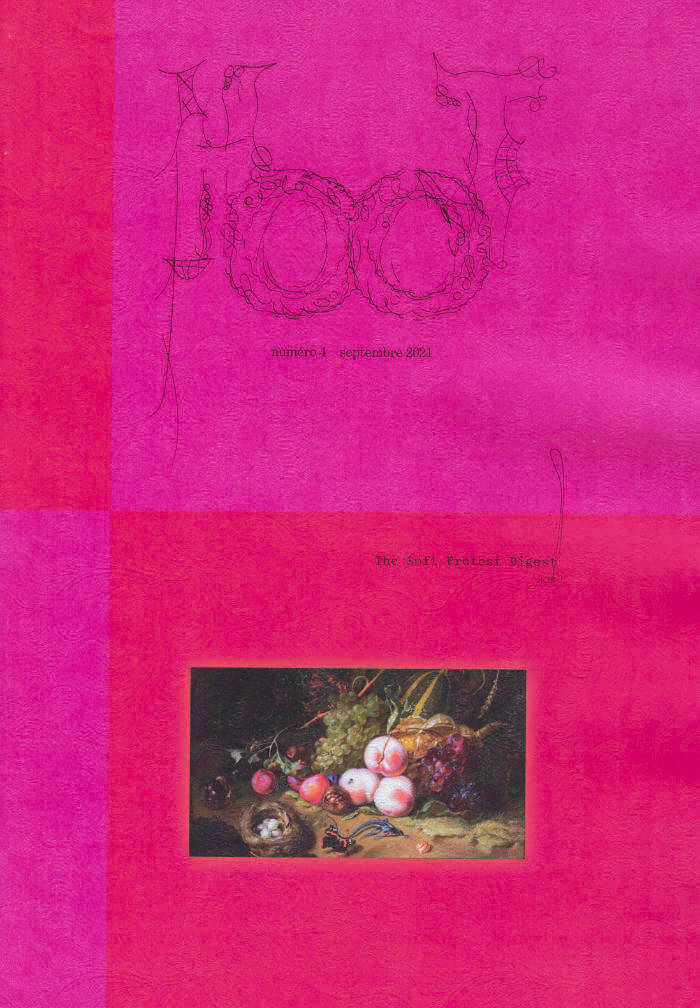
HOOT nr. 4 — The Soft Protest Digest
Gufo, Clément Faydit and 1 more
The Soft Protest Digest centre ses recherches sur l'histoire de l'alimentation, de l'agriculture et des liens sociaux et politiques qui constituent une culture alimentaire. Le collectif croit en l'utilisation de la narration comme moyen de créer ou d'adapter des traditions alimentaires, des recettes et des façons de se nourrir qui tiennent compte de l'héritage culturel et des liens émotionnels entre celleux qui mangent et la gastronomie locale, dans une quête de résilience alimentaire.
Gufo a souhaité rencontrer les membres de ce collectif afin d’explorer les nécessités alimentaires dans lesquelles s’inscrit The Soft Protest Digest. Et puis, très vite, une intrigue s’est créée autour du nom de ce collectif : qu’est-ce qu’une douce manifestation ? Quels sont les liens avec l’alimentation ? Pouvons-nous doucement contester ? C’est-à-dire sans frustration ni violence ? Ce nom a fait écho à une édition dont j’ai imprimé le titre il y a quelque temps, il s’agit de “Radical softness as a boundless form of resistance”* ( dont la traduction pourrait être Une douceur radicale comme forme infinie de résistance). Pouvons-nous associer douceur, résistance, radicalité et alimentation ? Gufo vous invite alors, à lire nos conversations qui divaguent mais surtout à imaginer des banquets partagés dont la joie et les ventres pleins seront les témoins d’onctueuses révoltes.

Sekxphrastiks
"How to write about a poet as honed? I wish for this magic in every book of poems I open, but it rarely is. Jane Goldman raps from inside our heads, do you get it, do you hear this, it is time to understand these things, these raw-lipped dadas without you-At the same time, her book pulls itself around us, and we get a new feeling about poetry, a subject we thought we knew well. I LOVE THIS BOOK!!! WOW RIGHT FROM THE START AND IT JUST GOES GOES GOES!!!" - CAConrad, author of While Standing in Line for Death (Wave Books, 2017)
Jane Goldman lives in Edinburgh and is Reader in English at the University of Glasgow. She likes anything a word can do. Her poems have appeared in a number of magazines and anthologies, as well as in the weird folds: everyday poems from the Anthropocene, edited by Maria Sledmere and Rhian Williams (Dostoyevsky Wannabe, 2020), and in the pamphlet, Border Thoughts (Sufficient Place/Leamington Books, 2014). SEKXPHRASTIKS is her first full length collection.
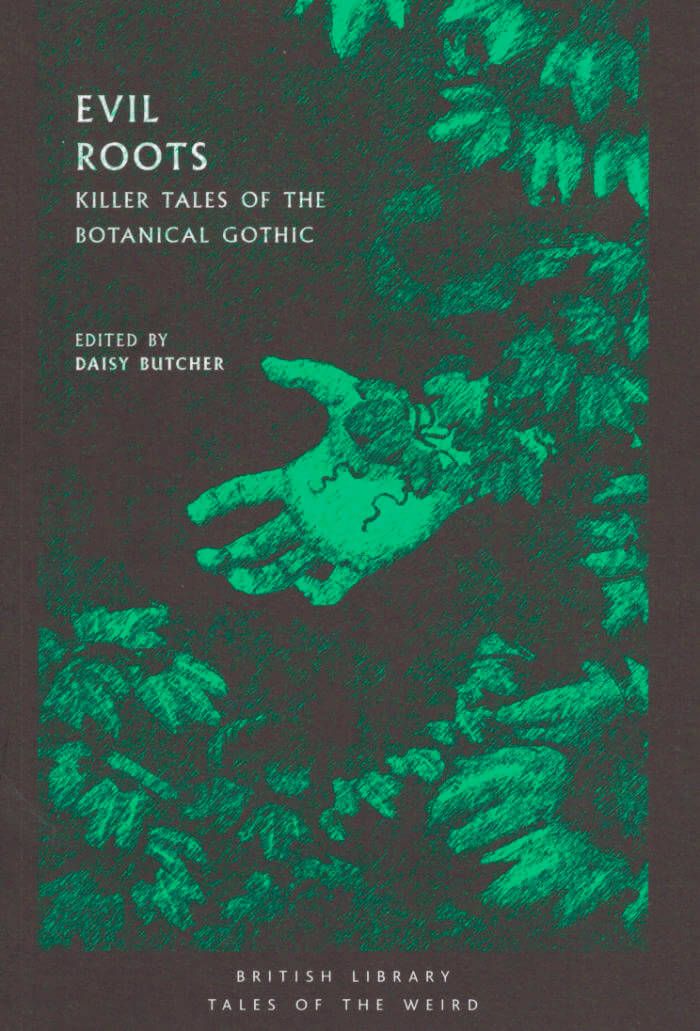
Evil Roots: Killer Tales of the Botanical Gothic
Strangling vines and meat-hungry flora fill this unruly garden of strange stories, selected for their significance as the seeds of the "killer plant" trope in fiction, film, and video games.
Before the Demogorgon of Stranger Things and the appearance of Mario's iconic foe the Piranha Plant, writers of the 19th and early 20th centuries were exploring the lethal potential of vegetable life, inspired by new carnivorous species discovered on expeditions into the deep jungles of the world and breakthroughs in the grafting and genetics disciplines of botany. Suddenly, the exotic orchid could become a curiously alluring, yet unsettlingly bloodthirsty menace; the beautifully sprawling wisteria of the stately home could become anything but civilized, and the experimentation of botanists weening new shoots on their own blood could become fuel for a new genre of horticultural nightmare.
Every strain of vegetable threat (and one deadly fungus) can be found within this new collection, representing the very best tales from the undergrowth.
Daisy Butcher is a Gothic and Horror scholar attached to The Open Graves, Open Minds project. Her research focuses on the monstrous feminine and body horror from the 19th century Gothic short story to modern film and TV.
Published 2020

Dan Graham: Theatre
A facsimile of Graham's ultra-rare artist's book documenting early performance works.
Originally published in 1978 and produced here in facsimile form, Theatre is an artist's book documenting seven early performance works by Dan Graham (born 1942) taking place from 1969 to 1977, with notes, transcripts and photo documentation for each performance. These performances catch the artist at a unique moment, as he shifts away from his early media works and towards his hallmark video and written work around underground music and youth culture.
The works in Theatre focus primarily on the psychological and social space between individuals and the roles they serve inside the arena of performance, subverting them by creating conditions by which a performer or audience simultaneously functions as both (creating a type of feedback loop through social transgression). Like most of Graham's work, these performances also serve as a critique of cultural norms, with many of the performances utilizing quotidian, social acts that are amplified over time.
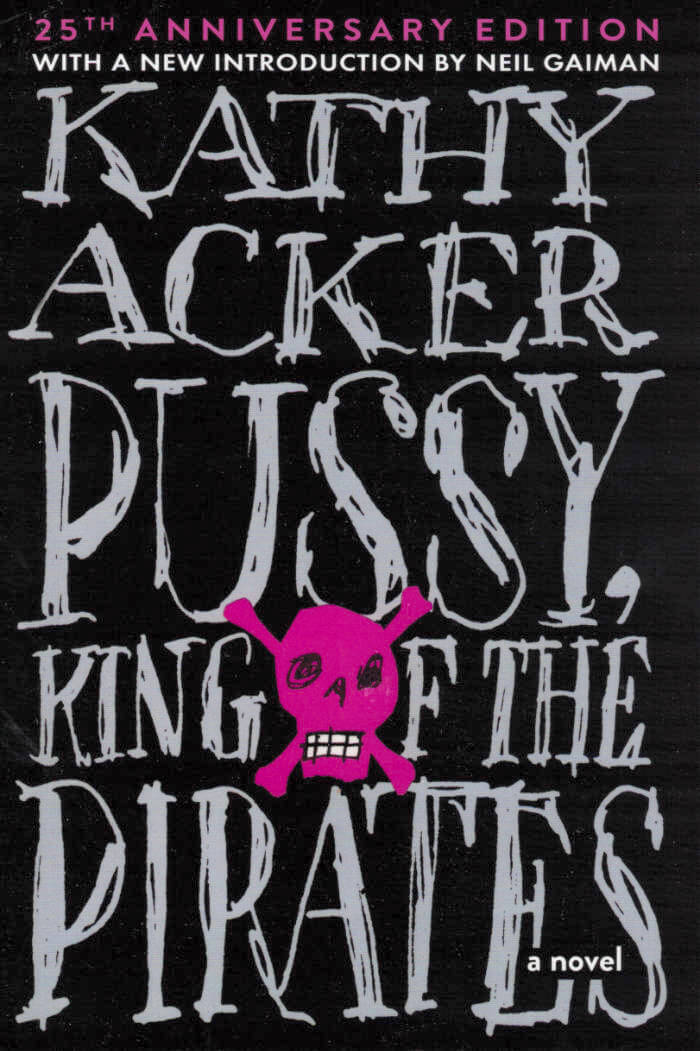
Pussy, King of the Pirates
Loosely related to Robert Louis Stevenson's classic Treasure Island, Pussy, King of the Pirates is a grrrl pirate story that journeys from the most famous whorehouse in Alexandria through an unidentified, crumbling city that may or may not be sometime in the future, to Brighton Town, England, and, finally, to a ship headed toward Pirate Island, where the stories converge and the vision ends.
Ransacking world history, literature, and language itself to speak to the current zeitgeist, Pussy, King of the Pirates is the literary analogue to the wild girl energy that dominates our rock and roll culture in the 1990s. A daring and passionate litany of disparate narratives and voices, poetry and prose, words and images, Kathy Acker's newest novel is perhaps her most subversive to date. Her meditations on love, sex, death, and art have made her a writer like no one else working today.

Zami: A New Spelling of My Name: A Biomythography
Zami: A New Spelling of My Name is a 1982 autobiography by African-American poet Audre Lorde. It started a new genre that the author calls biomythography, which combines history, biography, and myth. In the text, Lorde writes that "Zami" is "a Carriacou name for women who work together as friends and lovers," Carriacou being the Caribbean island from which her mother immigrated.
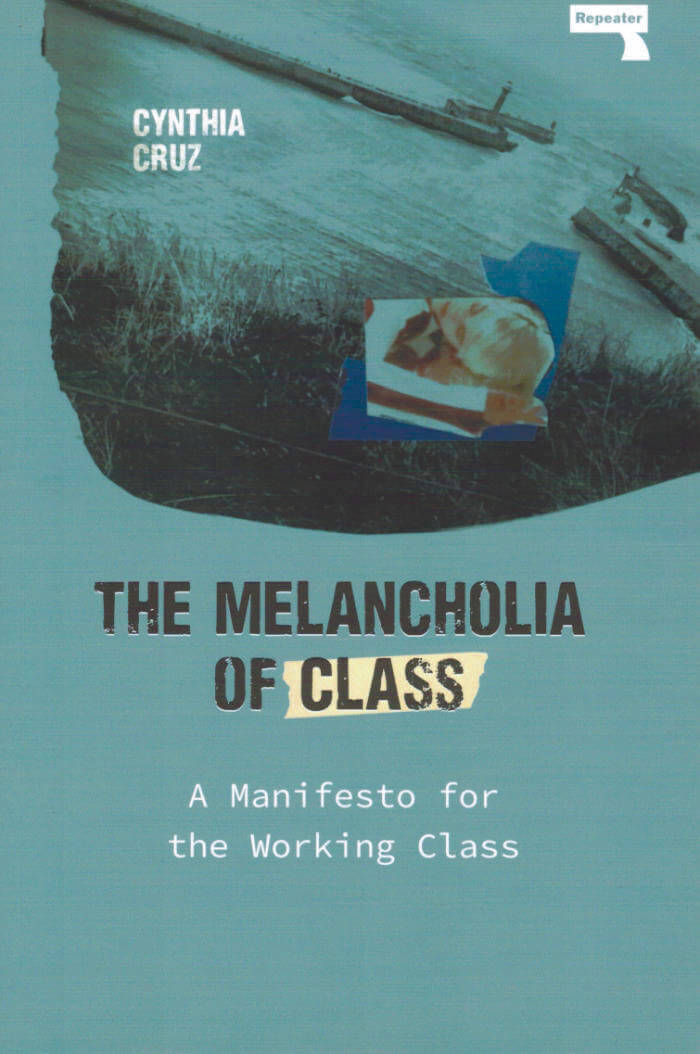
The Melancholia of Class: A Manifesto for the Working Class
In The Melancholia of Class, Cynthia Cruz analyses how this choice between assimilation or annihilation has played out in the lives of working-class musicians, artists, writers, and filmmakers — including Amy Winehouse, Ian Curtis, Jason Molina, Barbara Loden, and many more — and the resultant Freudian melancholia that ensues when the working-class subject leaves their origins to "become someone," only to find that they lose themselves in the process.
Part memoir, part cultural theory, and part polemic, The Melancholia of Class shows us how we can resist assimilation, uplifting and carrying our working-class origins and communities with us, as we break the barriers of the middle-class world. There are so many of us, all of us waiting. If we came together, who knows what we could do.
Cynthia Cruz is the author of six collections of poems: Dregs, How the End Begins, Wunderkammer, The Glimmering Room, Ruin, and Guidebooks for the Dead. Disquieting: Essays on Silence, a collection of critical essays on marginalization and silence, was published by Book*hug in 2019. Her first work of fiction, a novella, Steady Diet of Nothing, is forthcoming. She teaches at the City College of New York and in the MFA Writing Program at Columbia University.
Published 2021
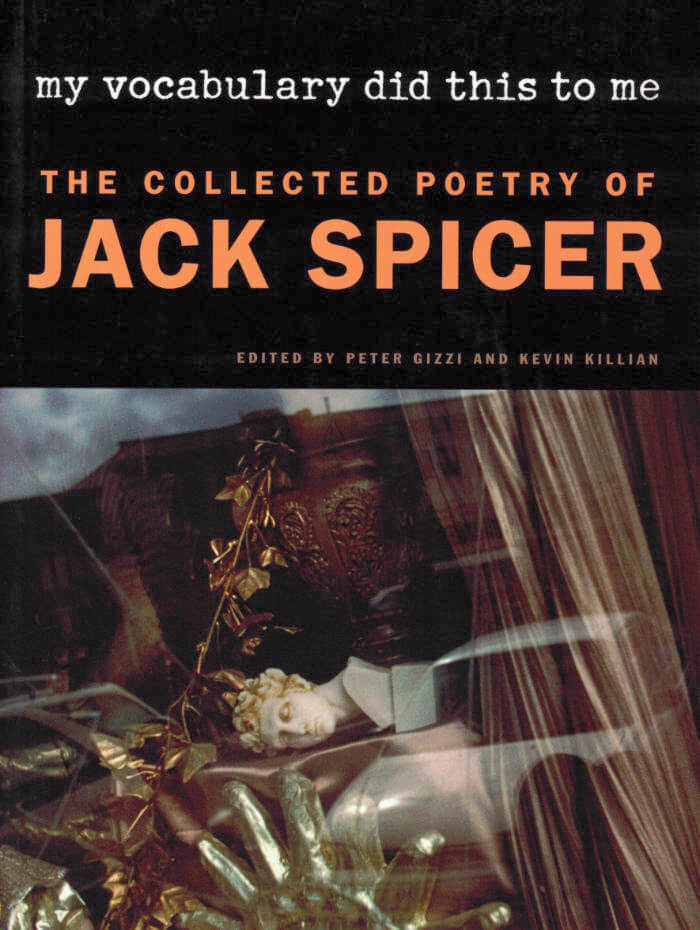
My Vocabulary Did This to Me: The Collected Poetry of Jack Spicer
In 1965, when the poet Jack Spicer died at the age of forty, he left behind a trunkful of papers and manuscripts and a few copies of the seven small books he had seen to press. A West Coast poet, his influence spanned the national literary scene of the 1950s and '60s, though in many ways Spicer's innovative writing ran counter to that of his contemporaries in the New York School and the West Coast Beat movement. Now, more than forty years later, Spicer's voice is more compelling, insistent, and timely than ever. During his short but prolific life, Spicer troubled the concepts of translation, voice, and the act of poetic composition itself.
My Vocabulary Did This to Me is a landmark publication of this essential poet's life work, and includes poems that have become increasingly hard to find and many published here for the first time.
Edited by Kevin Killian and Peter Gizzi

Imago (Lilith's Brood #3)
After the near-extinction of humanity, a new kind of alien-human hybrid must come to terms with their identity — before their powers destroy what is left of humankind. Since a nuclear war decimated the human population, the remaining humans began to rebuild their future by interbreeding with an alien race — the Oankali — who saved them from near-certain extinction. The Oankalis' greatest skill lies in the species' ability to constantly adapt and evolve, a process that is guided by their third sex, the ooloi, who are able to read and mutate genetic code.
Now, for the first time in the humans' relationship with the Oankali, a human mother has given birth to an ooloi child: Jodahs. Throughout his childhood, Jodahs seemed to be a male human-alien hybrid. But when he reaches adolescence, Jodahs develops the ooloi abilities to shapeshift, manipulate DNA, cure and create disease, and more. Frightened and isolated, Jodahs must either come to terms with this new identity, learn to control new powers, and unite what's left of humankind — or become the biggest threat to their survival.

rosa rosa rosae rosae
Produced in conjunction with the exhibition that took place at Maison Pelgrims (10/9-23/10/2021), the book presents original interventions by the artists of the rosa rosae rosae project : Alicia Jeannin, Alicja Melzacka, Angela Detanico & Rafael Lain, Annaïk Lou Pitteloud, Audrey Cottin, buren, Charlie Usher, Eleanor Ivory Weber, Eva Giolo, Henry Andersen, Jan Vercruysse, Maíra Dietrich, Marc Buchy, Maxime Jean-Baptiste, Niels Poiz, Oriol Vilanova, Sabir (Lucie Guien, Amélie Derlon Cordina, Sophie Sénécaut / Perrine Estienne, Kevin Senant, Maud Marique, Pauline Allié, Carole Louis), Slow Reading Club, Sofia Caesar, Surya Ibrahim, Yiannis Papadopoulos, Yoann Van Parys
Edited by Pauline Hatzigeorgiou / SB34
Graphic design by Tipode Office
The book was produced with the support of Fédération Wallonie-Bruxelles (aide à l'édition) and Région Bruxelles-Capitale (Image de Bruxelles)

The COVID-19 Kink Zine
An infectious disease occasionally promotes certain ways of intimacy. For instance, health officials from New York and British Columbia suggested the use of glory holes as part of measures on dating and sex during the coronavirus pandemic to prevent face-to-face contact. Queerness can arise as an unforeseen side effect of the measures against the disease. We can further this by misusing the language of public hygiene as symbols of kink, a face mask as a ball gag, temporary floor marking tapes as bondage tapes, a PCR nose swab as a dilator. Online space, where fake news and memes flourish, is indeed an effective ground for these deliberate misunderstandings to propagate.
2022 February by Noam Youngrak Son
Cathair press (https://www.d-act.org/cathair.html)
@noam_yr
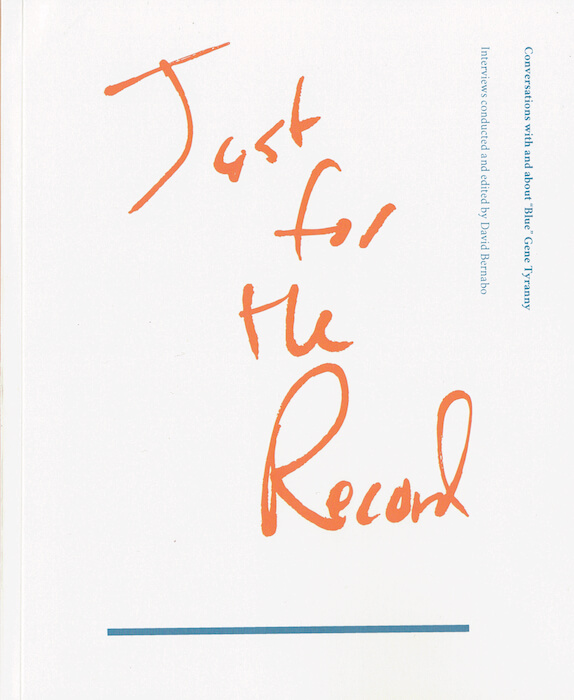
Just for the Record: Conversations with and about "Blue"Gene Tyranny
This book collects the extended interviews from the film, "Just For the Record: Conversations with and about "Blue" Gene Tyranny" (2020), including interviews with "Blue" Gene Tyranny, Joan La Barbara, Peter Gordon, Kyle Gann, David Grubbs, Nicole V. Gagné, Philip Perkins, Pat Oleszko, Tommy McCutchon, Jeff Berman, and Bill Ruyle.
"Blue" Gene discusses his life in San Antonio, Ann Arbor, Oakland, and New York, including stories of recording "Out of the Blue," touring with Carla Bley, shocking frat boys, and something known as "cookie Sunday." Interviews also discuss a variety of topics like the nature of reissuing records, improvisation and composition, and the lived experience of creating in places of activity.
Second edition of 50, yellow or red cover. 175 pages, perfect bound.
Published 2022.

The Telephone Book: Technology, Schizophrenia, Electric Speech
The telephone marks the place of an absence. Affiliated with discontinuity, alarm, and silence, it raises fundamental questions about the constitution of self and other, the stability of location, systems of transfer, and the destination of speech. Profoundly changing our concept of long-distance, it is constantly transmitting effects of real and evocative power. To the extent that it always relates us to the absent other, the telephone, and the massive switchboard attending it, plugs into a hermeneutics of mourning.
The Telephone Book, itself organized by a "telephonic logic," fields calls from philosophy, history, literature, and psychoanalysis. It installs a switchboard that hooks up diverse types of knowledge while rerouting and jamming the codes of the disciplines in daring ways. Avital Ronell has done nothing less than consider the impact of the telephone on modern thought. Her highly original, multifaceted inquiry into the nature of communication in a technological age will excite everyone who listens in. The book begins by calling close attention to the importance of the telephone in Nazi organization and propaganda, with special regard to the philosophy of Martin Heidegger. In the Third Reich the telephone became a weapon, a means of state surveillance, "an open accomplice to lies." Heidegger, in Being and Time and elsewhere, elaborates on the significance of "the call." In a tour de force response, Ronell mobilizes the history and terminology of the telephone to explicate his difficult philosophy.
Ronell also speaks of the appearance of the telephone in the literary works of Duras, Joyce, Kafka, Rilke, and Strindberg. She examines its role in psychoanalysis—Freud said that the unconscious is structured like a telephone, and Jung and R. D. Laing saw it as a powerful new body part. She traces its historical development from Bell's famous first call: "Watson, come here!" Thomas A. Watson, his assistant, who used to communicate with spirits, was eager to get the telephone to talk, and thus to link technology with phantoms and phantasms. In many ways a meditation on the technologically constituted state, The Telephone Book opens a new field, becoming the first political deconstruction of technology, state terrorism, and schizophrenia. And it offers a fresh reading of the American and European addiction to technology in which the telephone emerges as the crucial figure of this age.

Perverse Decolonization?
Jan Sowa, David Riff and 1 more
Conversations and essays that question the twisted and oppressive climate in a world where true decolonization has yet to begin.
New nationalisms, toxic patriotisms and systems of exclusion have been on the rise for the last decade, reinforced by technology and rooted in colonialism, slavery and class oppression. Our time offers a unique twist on these age-old structures: rhetorics of decolonization are now weaponized by autocratic regimes, just as they are normalized in the phantasmagoria of cultural practices. It is this paradoxical and entangled situation that we, perhaps somewhat emotionally, started to refer to as "perverse decolonization." This book is the result of a (self-)critical project of discussions, workshops, exhibitions and meetings in Cologne, Poland, Israel, Hong Kong and Chicago. Its conversations and essays question the twisted and oppressive climate in a world where true decolonization has yet to begin.
Contributions by Avital Barak, Saddie Choua, Cosmin Costinaş, Ekaterina Degot, Natasha Ginwala, Andrzej Leder, Georgy Mamedov, Walter Benn Michaels, Joanna Rajkowska, David Riff, Aneta Rostkowska, Joshua Simon, Jan Sowa, Hito Steyerl, Mark Terkessidis, Mi You.
Published in February 2022
English edition
15 x 21 cm (softcover)
164 pages

Xenogenesis
An extensive and comprehensive polyphonic exploration of the work of The Otolith Group, coming at a pivotal point in their practice.
The work of this London-based artist's collective comprised of Anjalika Sagar and Kodwo Eshun covers politics of race and diversity and incorporates film making and post-lens-based essayistic aesthetics that explore the temporal anomalies, anthropic inversions, and synthetic alienation of the posthuman, the inhuman, the non-human, and the complexity of the environmental conditions of life we all face.
Presenting all bodies of work contained in the Xenogenesis exhibition, this publication includes many materials and graphics from The Otolith Group's broader practice, including performance, lecture and research material. The outcome of over four years of collaboration, research and conversation, the publication is not a chronological exhibition catalogue or retrospective but a cross-section of their work which includes substantial contributions from the artists themselves, in the form of writing and direct engagement with its production.
The publication also brings together important thinkers, scholars, art historians and writers from disparate fields, who know and have worked with the group, as well as those who are writing from a contemporary perspective. They include Denise Ferreira da Silva, Annie Fletcher, Anselm Franke, Shanay Jhaveri, George E. Lewis, Mahan Moalemi, Fred Moten, Grant Watson, Vivian Ziherl and the late Mark Fisher each of whom reflect on a particular aspect of the Group's practice with supplementary materials such as archival images, documented conversations, early lecture performances as well as other accompanying texts and examinations of their research sites.
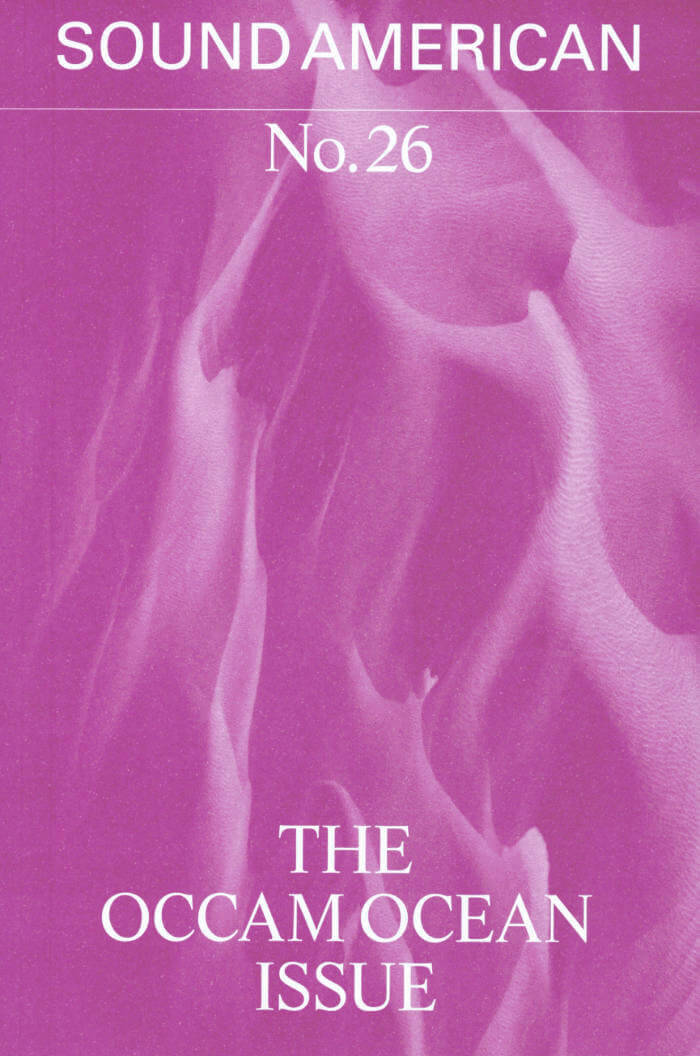
Sound American #26 – The OCCAM Issue
An issue dedicated to Éliane Radigue's ground-breaking compositional work, OCCAM Ocean as seen through the eyes of her chevaliers de Occam, the performers who, in collaboration with Radigue, have brought the sprawling musical eco-system to life.
Sound American releases for its twenty-sixth issue the OCCAM Issue, which focuses on the radical musical eco-system of French composer Éliane Radigue's OCCAM Ocean project. In a first for the publication, this issue is built solely around interviews with the performers that have collaborated with Radigue to produce this body of work over the last decade. Contributors include Charles Curtis, Carol Robinson, Rhodri Davies, Catherine Lamb, Julia Eckhardt, Silvia Tarozzi, Dafne Vicente-Sandoval, Laetitia Sonami, and Frédéric Blondy. All interviews were conducted by SA's editor, Nate Wooley, also a performer of Radigue's music. The issue features an opening invocation from Radigue herself, followed by writing on the history and practice of the OCCAM pieces, interviews, and a concluding essay by Wooley on his own experience performing OCCAM X. This special issue concludes with the last of a three-part series of “exquisite corpse” compositions, written especially for SA by inti figgis-vezueta in response to the preceding work of Moor Mother and Amirtha Kidambi.
This issue also comes with a special one-of-a-kind pull-out poster detailing the entire OCCAM Ocean composition in all of its interconnected glory. Designed by Remake Designs, this is a unique graphic perspective on the human web of collaboration that Radigue has created.

Je dors, je travaille
Conceived as a "bio-monograph", this catalogue offers a unique insight into the life and work of the French artist, sculptor and ceramist Valentine Schlegel. It features a large iconography, archives, and texts by sculptor and Schlegel specialist Hélène Bertin.
Valentine Schlegel developed her constantly changing daily art practice between Paris and Sète. Like a Swiss Army knife, she eventually mastered several techniques, producing everyday objects with sculptural shapes that include wooden flatware, ceramic vases, leather bags, and plaster fireplaces. Designed without any inherent hierarchy, and often in collaboration with the artist's friends, this body of work is made up of objects in a range of sizes and uses, from the fantastic to the quotidian. Schlegel also created many architectural elements in plaster intended for home interiors. Because of their immovable nature, these sculptures for everyday life are also the reason why Schlegel's work has remained little known. If she did not address only the world of art exhibitions through her work, she was nevertheless part of historic events at the Musée des Arts Décoratifs at a time when the Pompidou Center did not exist.
Today, through Schlegel's practice, this publication, conceived as a "bio-monograph" devoted to Valentine Schlegel, seeks to highlight other addresses of art. Including new iconography and archival material, with biographical notes written by Hélène Bertin that provide readers with a clearer picture of both Schlegel and her approach, this reference monograph documents for the first time all of the fireplaces that Valentine Schlegel created for private homes—about one hundred from 1959 to 2002. The other aspects of her work are also discussed in order to understand the whole of her practice, intimately linked to her way of life, where the questions of autonomy of production and friendship are central.
Fourth edition (2021), expanded edition with English texts.

Be Good, If You Can't Be Good, Be Good at It Boom Boom Boom Boom
Rebecca Jane Arthur, Eva Giolo
BE GOOD, IF YOU CAN’T BE GOOD, BE GOOD AT IT Boom Boom Boom Boom is a publication composed of letters, notes, anecdotes,translations, stills and images: all traces of the creative process. The artists Rebecca Jane Arthur and Eva Giolo bring together their correspondence on the act of writing and of filmmaking, in all its complexity, struggles and playfulness.
The letters unpack themes such as the challenge of making personal work and the strength found in sharing vulnerability; the act of writing itself, language and translation; writing on moving images, on their practices and that of others; and the notion of a place as a container of memories, of interiority and the confrontation with home. The publication uses words and texts as images, and all images of persons or things are hidden. The publication acts as a negative to the films that we create, revealing that which cannot be.
Publisher: Les éditions du CVB
Publication Date: March 2021
Language : English & French
ISBN: 978-2-9601799-7-2
Softback, 311 pages, fully illustrated
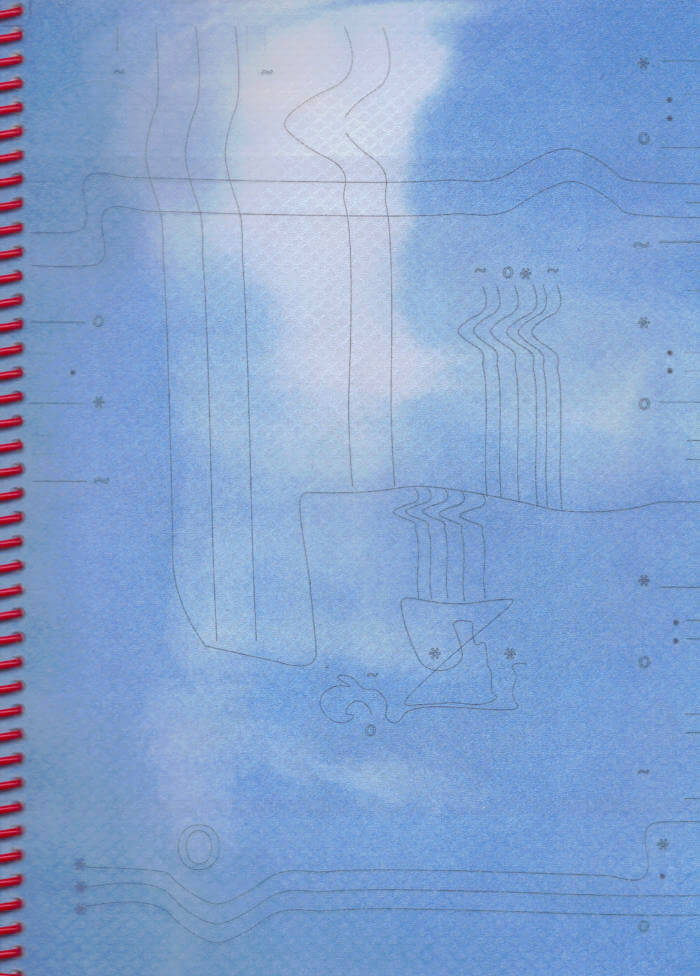
Under the Rainbow - Over the Weather
Speculative fiction magazine with contributions by 16 international (comic)artists/ writers/ designers/ curators/ witches. Exploring the world in the 4th millennium through images, words and dreamscapes.
Plastic coil bound with plastic covers.
Transparent cover with “A Short Manifesto” by Dutch conceptual artist Stanley Brouwn.
48 fold out pages, 185x262mm (foldes out to 185x365)
Riso printed on 100gr Munken Lynx by Hocus Bogus Publishing
Edition of 150
Cover design by Finn Melvin Caird
Design, layout and proofread by Yahaira Brito Morfe
Edited, printed and bound by Dennis Muñoz Espadiña
Language: English

SSaliva: Landscapes
‘Landscapes’ is a first attempt to highlight Ssaliva’s visual work. Through a selection of 100 images – digital paintings based on original photographs or screenshots – the book takes us on a scenic journey into the artist’s mind. Recalling a wide variety of references from the fields of photography, painting, landscape architecture and even Internet art, Ssaliva’s paintings bear witness to a wistful sensitivity to urban and rural exploration. Ssaliva has made his region a real playground. Walking through the “indeterminate” or empty spaces of Liège and its surroundings, the artist showed his empathy for the interstices and other abandoned places charged with history. This is what he tried to transcribe in the modification of his digital paintings: A veil wrapping his landscapes in mysteries. With this book, Ssaliva sets a coherent backdrop to his musical production, further completing the puzzle of an instinctive body of work inscribed in the pure romantic tradition.
"François Boulanger is an audiovisual artist born in Liège, Belgium in 1983. He started producing music by the end of the 90’s/early 2000’s and producing his visual work around 2010. Active under several monikers, he started his experimental project ‘Ssaliva’ in 2011 which today covers the entire spectrum of his works. Under this alias, he developed hypnotic soundscapes based on sparse rythms, lush tones and crystallised textures. A personal and romantic rendition of a life amidst nature and city pollution.
His work as Ssaliva also consists of documenting equally ethereal and removed places in pictures, two compulsive and lonely processes that have made him accumulate thousands of strange, escapist mental landscapes. His approach to visual arts is similar to music in terms of process too, stretching images and melodies, compressing bits of it, adding colors and samples until they become part of his own vision. Sometimes ghostly, sometimes sacred, an instantly recognizable form of melancholia.” — Munix